| Article ID | Journal | Published Year | Pages | File Type |
|---|---|---|---|---|
| 2740142 | Sports Orthopaedics and Traumatology | 2016 | 6 Pages |
BackgroundDespite current published reports, a thorough understanding of the natural history of non-operatively treated full thickness tears remains limited. The rate and risk of tear progression, increasing fatty infiltration, muscle atrophy, and other factors of symptomatology are not completely understood.Case DescriptionWe present a 10-year course of non-surgically treated full thickness supraspinatus tear in a relatively young patient. Initial operative treatment was recommended, but the patient refused and pursued physical therapy and continuation of an active lifestyle. Over the decade in which the patient remained asymptomatic he had minimal progression of cuff pathology as shown by MRI.Literature ReviewWhile several studies have been published discussing outcomes of non-operatively managed full thickness rotator cuff tears, there are no reports involving this demographic over such an extended period of time [4], [14], [15], [26] and [27]. Current studies following the conservative courses of full thickness tears range from averages of 1.9 to 5 years in length of follow-up and mean age ranges from 52 to 64 years [4], [14], [15], [26] and [27]. Due to concerns with the advancement of pathology with worsening long-term outcomes, surgical intervention is typically recommended for relatively young patients with symptomatic full thickness tears [22].Clinical RelevanceWith this case, we seek to portray a scenario in which the algorithmic thinking of operative treatment as the standard in young patients may be studied more extensively. It is also unique in that the continued use of the rotator cuff over an extended period of time did not contribute to a significant progression in tear size.
